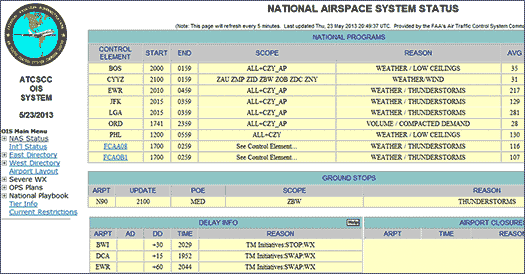
Checking the status of the National Airspace System (NAS) in advance of your flight can help save you time and money. Learning to check the NAS is really the key to FileSmart, allowing you to have the information needed to file early and file accurately.
Traffic Flow Management and the Causes of Delays
Traffic flow management (TFM), sometimes referred to as air traffic management, defines the flow of air traffic in the NAS based on capacity and demand. Delays can be caused by weather, special events, TFRs and excessive or unanticipated traffic.
When conditions are not favorable, either at an airport, or in a section of airspace, air traffic managers must find ways to slow down and reduce the volume of traffic in these areas. This is done through the use of traffic management initiatives (TMIs).
Understanding the NAS
Traffic management throughout the NAS is coordinated between the 20 En Route Centers across the continental United States, regional TRACON facilities and airport control towers. These facilities, in turn, report to the FAA’s Air Traffic Control System Command Center (ATCSCC), which acts as the nexus point for the daily management of the NAS.
Traffic managers are in charge of using TMIs to handle constraints in the system and, regardless of what TMI is being used, there will be an impact on flights. But, rather than waiting to react to what is happening, operators can be proactive in finding out what TMIs are being used and how to work with or around them.
Learn more about traffic flow management (TFM).
What Does it Mean to Check the NAS?
Before a flight, most pilots (hopefully) check the weather so that they understand how it will affect their flight. Likewise, it is critical for operators to understand what is going on in the airspace around them just as they would check weather and NOTAMs. We call this “Checking the NAS.”
Once operators develop the habit of checking the status of the NAS before a flight, they will find that they are able to be much more proactive, rather than reactive, in dealing with constraints and delays associated with TMIs.
For flight crews, this reduces their workload and can reduce delays associated with their flights. This allows them to be more efficient and provide better service to their respective companies.
At the same time, this practice benefits the NAS, as a whole. Informed pilots need less information from controllers, which gives controllers more time to focus on providing operators with optimal routes. Being aware of conditions in the NAS helps both you and your fellow pilots.
Sources for Information on the NAS
There are a number of ways to find information about what is happening in the NAS. Some information is available through public web resources, while other information is available through flight plan service providers.
Finding NAS Information Online
The primary source of public information about what is going on in the NAS is the FAA’s website, www.fly.faa.gov, particularly the tools located under the “Products” section of that site. These tools include the following:
- Operational Information System (OIS) page
- Advisories Database page
- Current Reroutes page
- Current Restrictions Page
- National Playbook Routes page
- EDCT Lookup page
Learn more about these tools for finding NAS information online.
Many constraints in the NAS are the result of convective weather, due to its severity and unpredictability. Another very useful online resource is the Collaborative Convective Forecast Product (CCFP). This resource is a great way to determine where air traffic managers are expecting constraints. With this insight, operators can often anticipate what TMIs will be used.
Additional Sources of Information
The FAA provides additional information on the topic of traffic flow management in their “Traffic Flow Management in the National Airspace System” online booklet.
Flight Plan Service Providers provide a valuable resource to operators, providing flight planning services, trip handling support and flight following. A number of providers offer information about what is happening real-time in the NAS.
While not a complete list, the following are some of the common flight plan service providers:
- ARINC DirectSM Flight Support Services
- Colt International
- CSC DUATS
- Fltplan.com
- Honeywell Global Data Center Flight Support Services
- Jeppesen
- Rockwell Collins Ascend Flight Information Solutions
- Universal Weather and Aviation, Inc.
Several aviation trade associations can provide information on the NAS and the concepts of TFM.
NBAA Air Traffic Services (ATS) represents the interests of business aircraft operators from the floor of the ATCSCC and provides real-time updates to ATS subscribers.
AOPA offers various resources regarding flight planning and airspace issues.
NATA offers their Flight Crew Briefings, which provide information on two of the most commonly used airports in the northeast – Teterboro (TEB) and Newark International (EWR).
